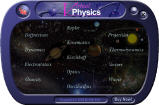|
Virtual Physics
Is the collection of programs simulating physical phenomena. The feature
of Virtual Physics is that you can perform and observe experiments you
can never see stars moving on their orbits or the motion of the molecules
of gas.
| Version: |
0.0.0.0 |
Publisher: |
nahliksoft.com |
| File Size: |
9.64 MB |
System: | Windows 98/ME/NT/2000/XP |
| License: |
Free to try ($19.98) |
Limitations: |
|
| Date Added: |
11-08-2007 |
Requirements: |
|
Software Description:
Virtual physics is the collection of programs simulating physical phenomena.
They can be used as demonstration tools at school or for individual
studies and experiments at home. See what you can never see in nature!
The most exiting feature of Virtual Physics is that you can perform
and observe many experiments you can never see either in nature or in
the school laboratory, eg. stars moving on their orbits or the motion
of the molecules of gas. The program consists of 13 modules covering:
Diffraction, Dynamics, Electrostatics, Gravity, Kepler Laws, Kinematics,
Kirchhoff Laws, Optics, Oscillations, Projectiles, Thermodynamics, Vectors
and Waves. With the Diffraction module you can observe diffraction.
It occurs when light bends around an obstacle or, as in our experiment,
passes through a slit. If the slit is comparable or narrower than the
length of the light wave, the light bends. In fact the slit acts then
as a separate wave source. With the Dynamics module you can investigate
the motion of a block sliding down an inclined plane as a result of
Earth's gravity force. You will be able to see vectors of the forces
exerted on the block. In the Electrostatics module you can see how the
electric field, generated by a set of static charges, looks like. Both
the strength and the potential of the field can be represented by color
intensities in the simulation window. With the Gravity module you can
investigate gravitational interactions of celestial bodies. You can
define two, three or more objects like stars, planets, comets, spacecrafts
etc. The simulation window can be enlarged to full screen mode. Kepler
module lets you investigate motions of planets and other celestial bodies
in our Solar System. While this is a relatively simple, two-dimensional
model, it is very helpful in understanding Kepler's laws. With the Kinematics
module you will see how the same motion can be described in a number
of equivalent ways, using various terms. This module shows also how
using different coordinate systems helps in describing the motion in
as simple a way as possible. The Kirchhoff module can help you in developing
intuitions for basic notions that describe the electric current as well
as in understanding properties of simple electric circuits. With the
Optics module you can investigate two very common physical phenomena
we are all familiar with - reflection and refraction. They both occur
when e.g. a light wave crosses a boundary between two different media,
like water and air. With the Oscillations module you can investigate
oscillations of a mass on a spring or a mathematical pendulum. It is
interesting that the mathematical description of the two types of oscillators
is exactly the same. The phenomenon of a harmonic oscillator underlies
the design of lots of devices, from old-fashioned clocks to sophisticated
audio equipment. Projectiles module is an excellent opportunity to study
accelerated motion of bodies. In this particular case the acceleration
which determines the trajectory of a projectile is due to the Earth's
gravity. With this simple module you can follow trajectories of projectiles
and see how they change with varying parameters of the launch. With
this Thermodynamics module you can observe motions and interactions
of gas particles. It can help you in understanding the concept of temperature.
You can choose one or two gases. When there are two gases in the container,
you can set the width of the gap in the wall which separates them. Vectors
module can help you in understanding the operations of adding and subtracting
vectors. While many phenomena around us can be characterized by numbers
(like air temperature) others have not only value but also direction
and orientation - e.g. velocity of a car. With the Waves module you
can investigate waves and their interference in a one-dimensional medium,
like a string. You can also set the sound generation option.
Editor's Review:
The most exiting feature of Virtual Physics is
that you can perform and observe many experiments you can never see
either in nature or in the school laboratory, eg. stars moving on their
orbits or the motion of the molecules of gas.
User Comments:
[ Write
a comment fo r
this software ]
No user comments at present!
Related Programs:
- Petri .NET Simulator - Petri .NET Simulator has been designed for modeling, analysis and simulation of flexible manufacturing systems, but can be used for other discrete event systems as well.
- JupSat Pro - Predict Great Red Spot transit times and times of Jupiter's satellite phenomena including shadow transits and satellite eclipse times.
- physics 101 SE - Physics 101 SE is the premier physics calculation tool
- Winning Science Fair Projects GOLD - With dozens of award-winning science fair project examples, lessons and other tools to help you prepare a winning science fair project.
- Universal Converter - Convert UK and US values to their Metric counterparts and conversely.
- Tom Computer Simulator - It is a computer simulation designed to teach first time users how a computer works.
- Flow Pro - Hydraulic design software for professional civil engineers.
- Pocket Stars PC - Pocket Stars PC is a high accuracy ephemeris, star finder, and celestial navigation tool for the desktop PCs, tablet PCs and notebook PCs.
- DreamCalc Scientific Calculator - Provide a fully featured and convenient alternative to using a separate hand-held calculator when you are working on your PC.
- LunarPhase Pro - LunarPhase Pro provides everything you need to know about lunar phenomena, and include interactive Moon Atlas.
|



 Download Site 1
Download Site 1 Buy Now $19.98
Buy Now $19.98
